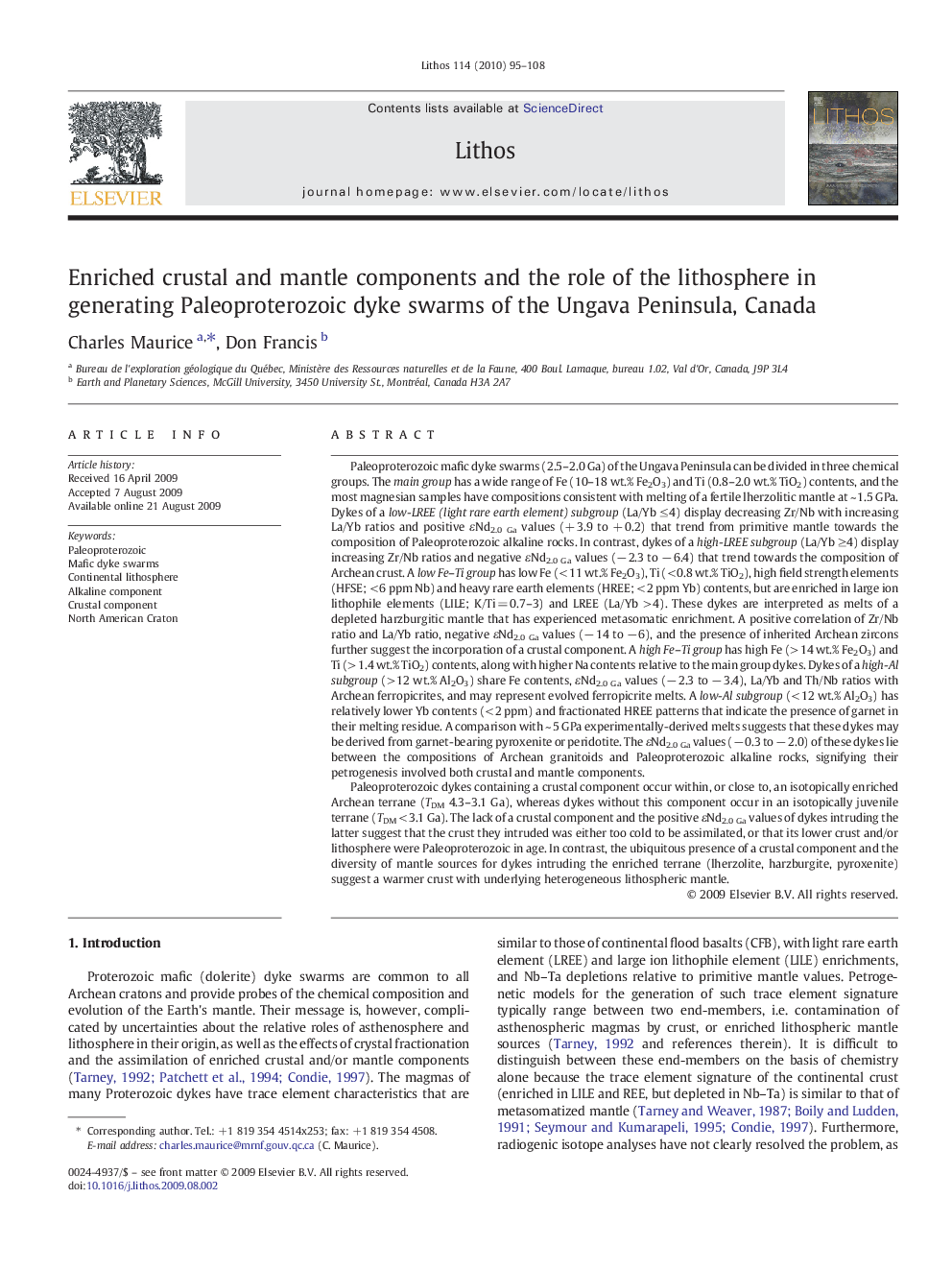| کد مقاله | کد نشریه | سال انتشار | مقاله انگلیسی | نسخه تمام متن |
|---|---|---|---|---|
| 4717306 | 1638737 | 2010 | 14 صفحه PDF | دانلود رایگان |

Paleoproterozoic mafic dyke swarms (2.5–2.0 Ga) of the Ungava Peninsula can be divided in three chemical groups. The main group has a wide range of Fe (10–18 wt.% Fe2O3) and Ti (0.8–2.0 wt.% TiO2) contents, and the most magnesian samples have compositions consistent with melting of a fertile lherzolitic mantle at ~ 1.5 GPa. Dykes of a low-LREE (light rare earth element) subgroup (La/Yb ≤ 4) display decreasing Zr/Nb with increasing La/Yb ratios and positive εNd2.0 Ga values (+ 3.9 to + 0.2) that trend from primitive mantle towards the composition of Paleoproterozoic alkaline rocks. In contrast, dykes of a high-LREE subgroup (La/Yb ≥4) display increasing Zr/Nb ratios and negative εNd2.0 Ga values (− 2.3 to − 6.4) that trend towards the composition of Archean crust. A low Fe–Ti group has low Fe (< 11 wt.% Fe2O3), Ti (< 0.8 wt.% TiO2), high field strength elements (HFSE; < 6 ppm Nb) and heavy rare earth elements (HREE; < 2 ppm Yb) contents, but are enriched in large ion lithophile elements (LILE; K/Ti = 0.7–3) and LREE (La/Yb > 4). These dykes are interpreted as melts of a depleted harzburgitic mantle that has experienced metasomatic enrichment. A positive correlation of Zr/Nb ratio and La/Yb ratio, negative εNd2.0 Ga values (− 14 to − 6), and the presence of inherited Archean zircons further suggest the incorporation of a crustal component. A high Fe–Ti group has high Fe (> 14 wt.% Fe2O3) and Ti (> 1.4 wt.% TiO2) contents, along with higher Na contents relative to the main group dykes. Dykes of a high-Al subgroup (> 12 wt.% Al2O3) share Fe contents, εNd2.0 Ga values (− 2.3 to − 3.4), La/Yb and Th/Nb ratios with Archean ferropicrites, and may represent evolved ferropicrite melts. A low-Al subgroup (< 12 wt.% Al2O3) has relatively lower Yb contents (< 2 ppm) and fractionated HREE patterns that indicate the presence of garnet in their melting residue. A comparison with ~ 5 GPa experimentally-derived melts suggests that these dykes may be derived from garnet-bearing pyroxenite or peridotite. The εNd2.0 Ga values (− 0.3 to − 2.0) of these dykes lie between the compositions of Archean granitoids and Paleoproterozoic alkaline rocks, signifying their petrogenesis involved both crustal and mantle components.Paleoproterozoic dykes containing a crustal component occur within, or close to, an isotopically enriched Archean terrane (TDM 4.3–3.1 Ga), whereas dykes without this component occur in an isotopically juvenile terrane (TDM < 3.1 Ga). The lack of a crustal component and the positive εNd2.0 Ga values of dykes intruding the latter suggest that the crust they intruded was either too cold to be assimilated, or that its lower crust and/or lithosphere were Paleoproterozoic in age. In contrast, the ubiquitous presence of a crustal component and the diversity of mantle sources for dykes intruding the enriched terrane (lherzolite, harzburgite, pyroxenite) suggest a warmer crust with underlying heterogeneous lithospheric mantle.
Journal: Lithos - Volume 114, Issues 1–2, January 2010, Pages 95–108